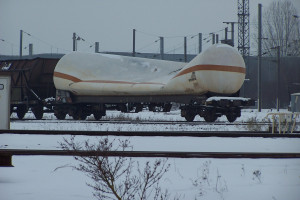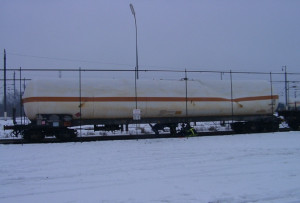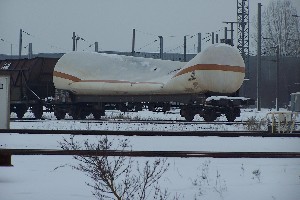An empty butadiene tanker car not yet degassed was in transit at a marshalling yard. Due to the ambient cold temperature (-17°C), the gaseous phase of the butadiene liquefied (Tboiling=-4.4°C); cistern pressure was drawn down by an estimated 0.35 bar (tank design threshold) and then collapsed. The railroad operator initiated the accident response procedure at 8 am: yard personnel were confined to the office and rail traffic was stopped in the yard. Arriving at 9 am, fire-fighters detected no cracks or explosion risks.
Since the cistern was incapacitated (by exceeding the rail gauge), its contents had to be transferred on-site. On 28th December, a compatible tanker car was dispatched for the purpose of transferring the butadiene; this operation began around midnight once the last train had cleared the main tracks. A 200-m safety perimeter was set up, yard personnel were evacuated and the catenary lines removed from service. Protected by a water curtain, fire-fighters forced butadiene out of the cistern by injecting inert gas (nitrogen). The 900 kg of liquid product were successfully decanted. During this operation, the pressure increase due to nitrogen injection combined with rising outside temperatures led to a sudden “re-swelling” of the cistern, whose geometry came to resemble its initial shape. The safety perimeter was reduced to 100 m at 3:35 that morning (29/12); yard activity resumed at 8 am. The tanker car was moved to the yard’s “hazardous freight” zone at 2:15 pm.
On 30th December, a small gas leak was detected on the car’s bottom valve, thus preventing any subsequent move of the car. The Moselle Prefecture ordered a complete degassing of the remaining butadiene on-site: the gas was eliminated by flaring on the 31st between midnight and 6 am. The yard’s internal emergency plan was lifted and rail traffic allowed to circulate normally on the 31st following a final inspection.
Nitrogen injection into degassed tanker cars, a typical step to avoid drawdown in tank pressure during cold weather (i.e. -10°C and below), had not been performed. Destruction of the tanker car resulted in a €200,000 loss.
Pressure drops, like that observed on 29th January 1976 (ARIA 40270, 40271 and 40272), had already yielded recommendations on maintaining a minimum 2-bar pressure in butane-type railcars during the winter months.
Two other accidents occurred in this same marshalling yard during the month (ARIA 39500 and 39703).
Download the detailed report in .pdf format (272 Kb)






